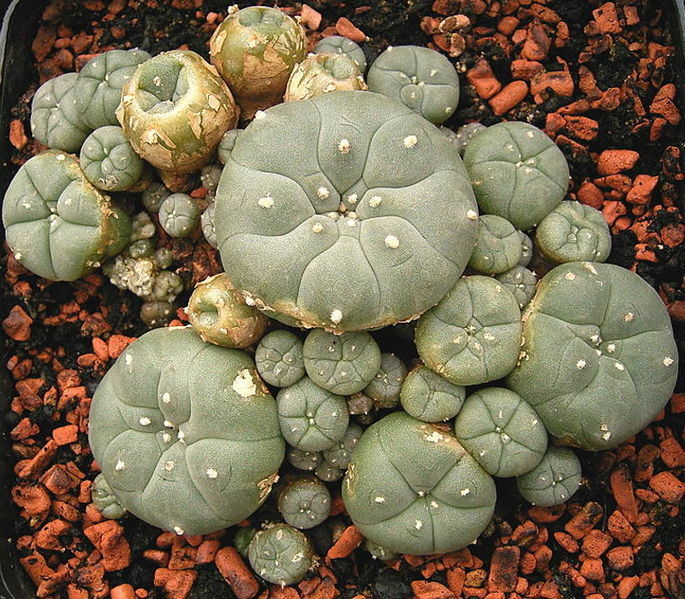Are Sacred Plants Important for the Healing and Reunification Processes of Indigenous Peoples of the Americas?
Sacred plants, or master plants, are ubiquitous in Indigenous cultures worldwide. Some examples are tobacco, peyote, ayahuasca, mushrooms, and coca. They constitute an important component in a spiritual movement driven by Indigenous peoples across the Americas to stop colonial oppression and destruction. Although similar efforts have existed long before the European colonization, it was not until the 20th century that a strong movement arose when organizations such as the Four Worlds International Institute (FWII), established in 1982 by Native American leaders, and the Inter-American Council on Indigenous Spirituality (CISEI in Spanish), established in 1999 by Indigenous leaders from all over the Americas, started to lead a regional change (CISEI; FWII).

Man holding coca leaf in Bolivia. by Marcello Casal Jr./ABr – Agência Brasil. Source: Wikipedia, via Creative Commons.
Both organizations where influenced by ancestral prophecies such as the Reunion of the Condor and the Eagle and the Return of the White Buffalo, In this regard, it is important to acknowledge that master plants, due to their condition of intermediaries in the relations among humans, animals, plants, minerals, and sacred spiritual beings, have been vital entities in the organization and construction of Indigenous societies of the Americas. Generally, healers and spiritual leaders across the region keep naming those plants as their source of knowledge and wisdom, and their consumption as a means to observe and understand what is beyond their limited human perceptions. Master plants are used for spiritual and physical healing purposes. Even though many sacred plants have psychedelic properties, they can cure effectively addictions to synthesized psychedelic and non-psychedelic drugs (Kavenská & Simonová, 2015; Tupper & Labate, 2014; Loizaga-Velder & Verres, 2014; Anderson, 2012). Indigenous peoples have benefited from master plants in the past and will continue to do so for the foreseeable future.
That continuation was declared by the FWII and the CISEI since their beginning. But what do exactly these organizations do? Well, a little of that information is presented here to frame the context within which the master plants work. The FWII “believe that there is a Fourth Way: Empowerment and Constructive Development” for an “Indigenous response” to the more than 500 years of systematic and systemic destruction driven by colonization (FWII, 2015, p.25). The first three ways are assimilation, resignation, and resistance. This Fourth Way is holistic and is guided by a set of principles that “constitute the foundation for the process of healing and developing ourselves (mentally, emotionally, physically, and spiritually), our human relationships (personal, social, political, economic, and cultural) and our relationship with Mother Earth” (FWII, 2015, p.14). Moreover, this plan is opened to include more Indigenous and non-Indigenous people attempting to create a better future. In a similar way, the CISEI “constitute a place for meeting, dialogue, and exchange — which would bridge ancestral indigenous wisdom and modern scientific knowledge” (CISEI 2016). Both organizations the FWII and the CISEI have implemented many agreements and actions that are consistent with the principles described above. But, at their heart, both of them are one single “spiritually-based movement” making its contribution to a collective healing process.
From an Indigenous perspective spirituality cannot be imposed rather it is shared. Nonetheless, our elders are conscious that “the most difficult part” of the healing process is “to talk about indigenous spirituality” (CISEI). As such, for them “the best way to understand it is through ceremonies” (CISEI). In this way, our knowledge keepers have made clear that the development of our collective healing process has been mainly conducted through ceremonies. There are, of course, several ‘normal’ procedures, such as diplomacy and political summits, that complement and are necessary for any advancement to be made. However, the maintenance of wisdom and knowledge received from master plants and spirits, and handed down by our elders from generation to generation, is highly dependent on ceremonies – which enable a cross-cultural communication when the main obstacle these leaders find is their restricted language. By doing so, master plants constitute a source of knowledge for Indigenous peoples and at the same time, they open the channels for transmission of this knowledge among peoples.
The CISEI (2016), on its webpage, states that “The work accomplished by ancestral master plants and traditional medicine in the process of conscience transformation, helps give way to a thorough investigation of the archetypal processes of human conscience at group and individual level.” Therefore, this is why it is so important for us, who are unfamiliar to these actions that have been taking place along Indigenous history, to be aware of the human-master plants relations surrounding the rise of the FWII and the CISEI.
The final paper of this project will by any means be a comprehensive review of the movement described here. Nonetheless, it will attempt to show what the role of sacred plants is and its importance for Indigenous peoples in modern times.

Peyote. By Frank Vincentz 18 Feb. 2007. Source: Wikimedia commons, via Creative commons.
References:
Anderson, B. T. (2012). Ayahuasca as antidepressant? psychedelics and styles of reasoning in psychiatry. Anthropology of Consciousness, 23(1), 44-59. doi:10.1111/j.1556-3537.2012.01056.x
Consejo Interamericano Sobre Espiritualidad Indígena (CISEI). (2016). Declarations. Retrieved from https://ciseiweb.wordpress.com/declarations/
Fourth World International Institute. (2015). The Fourth Way: An Indigenous Contribution to Building Sustainable and Harmonious Prosperity in the Americas and Beyond-2015-2019. Retrieved from https://es.scribd.com/document/265671129/The-Fourth-Way-2015-2019
Kavenská, V., & Simonová, H. (2015). Ayahuasca tourism: Participants in shamanic rituals and their personality styles, motivation, benefits and risks. Journal of Psychoactive Drugs, 47(5), 351-359. doi:10.1080/02791072.2015.1094590
Loizaga-Velder, A., & Verres, R. (2014). Therapeutic effects of ritual ayahuasca use in the treatment of substance dependence – qualitative results. Journal of Psychoactive Drugs, 46(1), 63-72. doi:10.1080/02791072.2013.873157
Tupper, K. W., & Labate, B. C. (2014). Ayahuasca, psychedelic studies and health sciences: The politics of knowledge and inquiry into an Amazonian plant brew. Current Drug Abuse Reviews, 7(2), 71-80.
 Follow
Follow